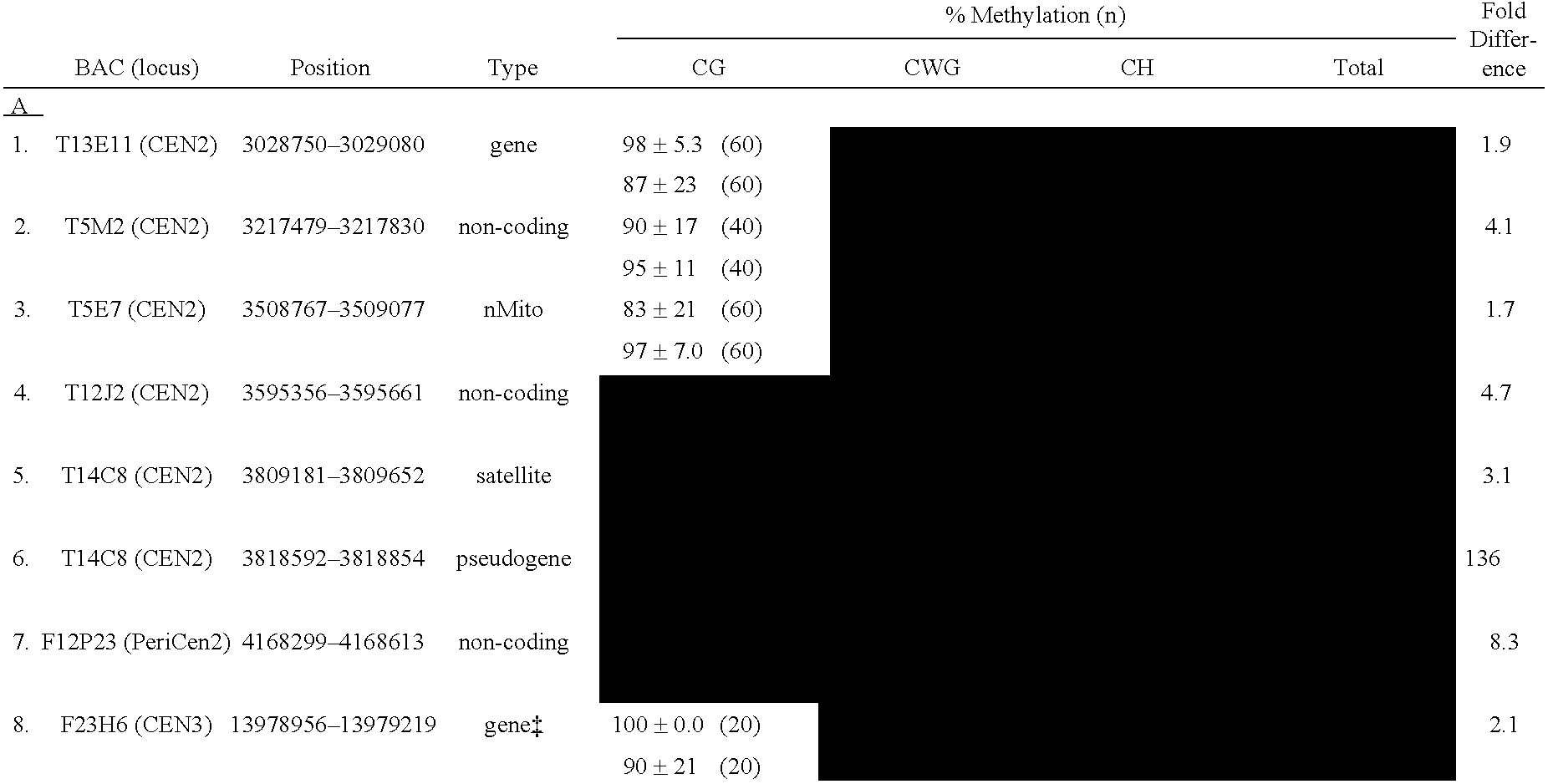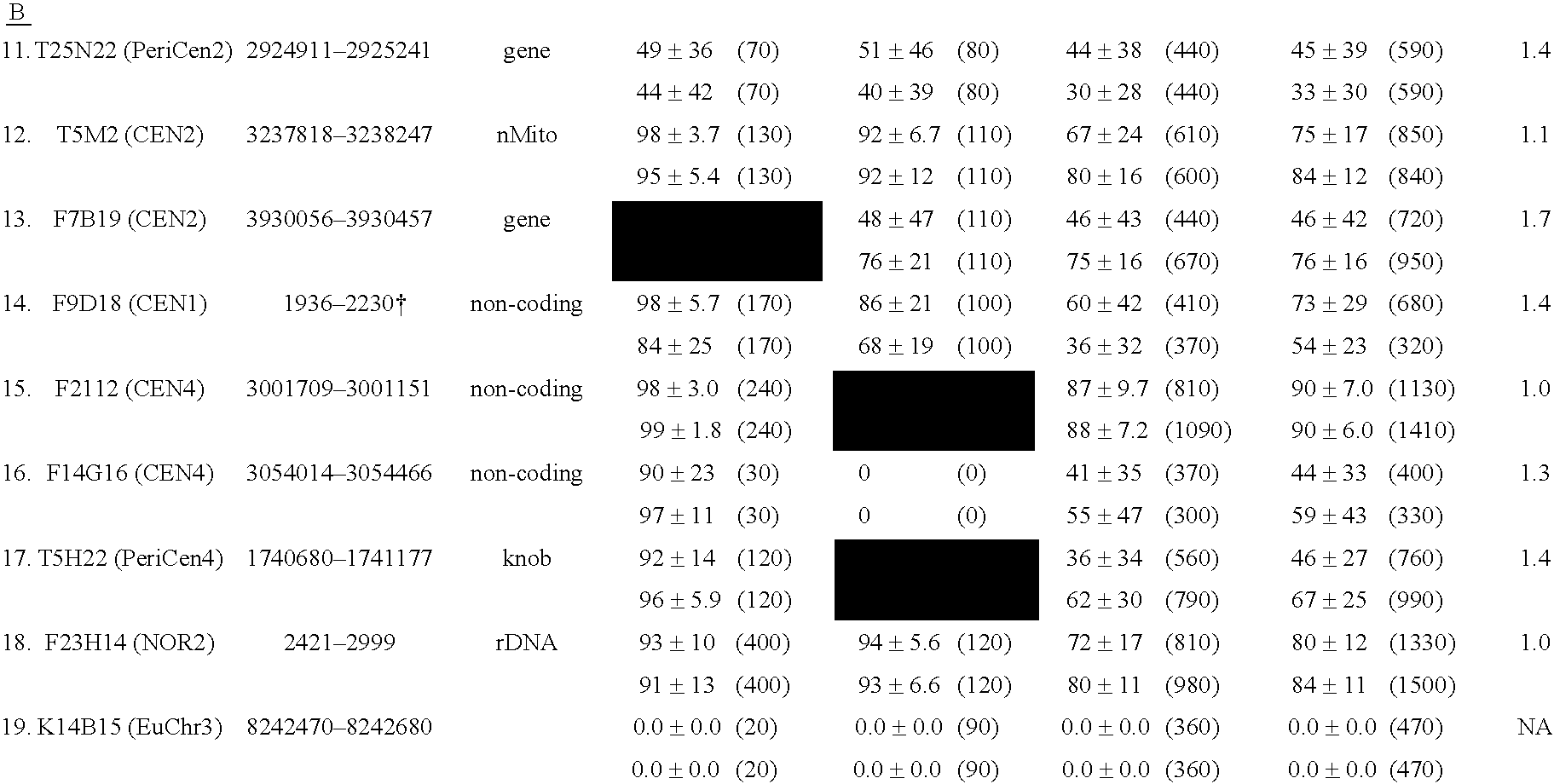Use of methylated nucleic acid segments for isolating centromere DNA
a technology of methylated nucleic acids and centromeres, applied in the field of molecular biology, can solve the problems of affecting the production of artificial chromosomes in higher organisms, affecting the production of artificial chromosomes, and unable to identify all the essential components of unicellular organisms, so as to reduce the efficiency of said transforming, reduce viability, and increase ploidy
- Summary
- Abstract
- Description
- Claims
- Application Information
AI Technical Summary
Benefits of technology
Problems solved by technology
Method used
Image
Examples
example 1
Isolation of Centromere Sequences
[0255]The methods described herein in Example 3 were used to successfully to isolate centromere DNA from Arabidopsis thaliana of the Columbia and Dijon ecotype. First, the CTAB method was used to extract high quality genomic DNA according to the method described in Example 3A. Using the methylation sensitive enzyme Hpa II, genomic DNA was cleaved and separated into different size fragments on an agarose gel as described in Example 3B. Highly methylated DNA (>5 Kb fragments) and unmethylated DNA or DNA with low levels of methylation (<5 Kb fragments) were isolated from the gel.
[0256]A Columbia (7.5× coverage of the genome) and a Dijon BAC library (2.6× coverage of the genome) filters from the TAMU BAC center (Texas A&M University) were then probed individually with 32P labeled methylated and unmethylated DNA fragments using the procedure set forth in Example 3C. In the study with the Dijon library 304 BACs were identified by the highly methylated DNA ...
example 2
Detection of Methylated Centromere Sequences
[0257]Known centromere sequences from Arabidopsis were used to analyze the abundance and patterns of methylation in centromeres. In Arabidopsis, over 5 Mb of sequence from the centromeric regions have been obtained, more than from any other higher eukaryote to date (see, e.g., “The Arabidopsis Genome Initiative,” Nature 408, 796, 2000; Copenhaver et al., 1999). The results of the study demonstrated that, unlike other heterochromatic portions of the genome, Arabidopsis centromeres contain distinct methylation profiles.
[0258]A. Sequencing Demonstrates Heavy Methylation of Centromere DNA.
[0259]Bisulfite sequencing, a method that allows direct assessment of methylation status, was used to demonstrate that the centromere regions of Arabidopsis contain high levels of methylation. This methylation was found to occur on cytosines in all possible contexts (e.g., CpG, CpNpG, or CpNpN). For the analysis, several sequences were analyzed from centromer...
example 3
Materials and Methods
[0281]A. Isolation of Genomic DNA
[0282]Tissue from Arabidopsis thaliana plants of the Columbia ecotype was harvested for DNA extraction. For DNA extraction, leaf tissue was cooled in liquid nitrogen, ground to a fine powder and transferred to an organic solvent-resistant test tube or beaker. Warm 2-ME / CTAB extraction solution (2% (w / v) CTAB, 100 mM Tris-Cl, pH 8.0, 20 mM EDTA, pH 8.0, 1.4 M NaCl, 2% β-mercaptoethanol) was added and mixed thoroughly and incubated for 10–60 min. at 65° C. with occasional mixing. The homogenate was extracted with an equal volume of 24:1 chloroform / octanol or chloroform / isoamyl alcohol, and was then centrifuged 5 min at 7500×g (8000 rpm in JA20; 10,000 rpm in a microcentriftige, for smaller samples), 4° C. The top (aqueous) phase was recovered and 1 / 10 volume 65° C. CTAB / NaCl solution was added. A second extraction with an equal volume of chloroform / octanol was performed as before and the aqueous phase was recovered. Nucleic acids w...
PUM
| Property | Measurement | Unit |
|---|---|---|
| size | aaaaa | aaaaa |
| size | aaaaa | aaaaa |
| size | aaaaa | aaaaa |
Abstract
Description
Claims
Application Information
 Login to View More
Login to View More - R&D
- Intellectual Property
- Life Sciences
- Materials
- Tech Scout
- Unparalleled Data Quality
- Higher Quality Content
- 60% Fewer Hallucinations
Browse by: Latest US Patents, China's latest patents, Technical Efficacy Thesaurus, Application Domain, Technology Topic, Popular Technical Reports.
© 2025 PatSnap. All rights reserved.Legal|Privacy policy|Modern Slavery Act Transparency Statement|Sitemap|About US| Contact US: help@patsnap.com



